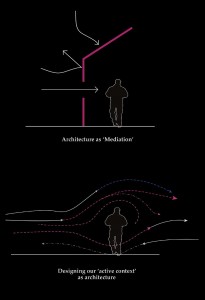Case study Sou Fujimoto, House N
Text Sean Lally, The shape of energy
Advanced architecture explores relations that are formed between architecture and its surroundings. Boundaries are a vital part of architecture, since the very first structures by humans, trying to get protected by the elements. Today our buildings make use of boundaries that are able to almost eliminate the influence of the changes of the environment indoors. Advanced architecture aims to restore this relationship by establishing new relational logics.
House N suggests a whole new relation between people, space and environment. Situated in a traditional Japanese neighbourhood, this exemplary building intends to visualize the contrast between the conventional housing and this new approach of space where you cannot define clearly where the outside becomes inside and vice versa. The house is comprised of three shells, each placed inside the other, defining different levels of privacy. The visual porosity of the prismatic structure enhances the feeling that the aim of Sou Fujimoto, when designing this building, was not to make an inside space rather than a gradation from the public to the private. Thus, in a time that this approach will be widely applied, the city will not be a consecutive change from indoors to outdoors but a field of gradual changes in the intensities of privacy. This way the boundary between nature and the building are blended. For Sou Fujimoto natural elements, such as trees can replace parts of the envelope of the building so that the building remains in a relationship with natural environment as well as the constant changes that occur in it.
In the text of Sean Lally, The shape of energy, the above topic of boundaries and nature is approached in a different way. Again, the architectural space is defined by forms of energy of the environment that are allowed to penetrate in order to be used by the architect as materials for the design of the space. This way architecture is directed by an energy balance equation; all forms of energy that cross the boundary of the space affect the whole system in a dynamic way which is not possible with our conventional constructing materials. In contrary to Sou Fujimoto΄s belief that architecture does not change but people and nature only change, Sean Lally envisions an architectural space that is constantly changing and adapting to the environment. Nevertheless, despite the two different theoretical approaches, the final space that would be produced has a lot in common. Even if Sou Fujimoto believes in the stability of architecture, the elements are allowed to enter his house and create a dynamic alteration of the way the user perceives and feels the space according to the parameter of time.
As future research, I would be interested in obtaining more knowledge in the topic of the dynamic architectural boundaries and explore what kind of changes they could induce in matters of privacy, social interaction or even interaction of the building with the user.
(Image Source Sean Lally, The Shape of Energy)

